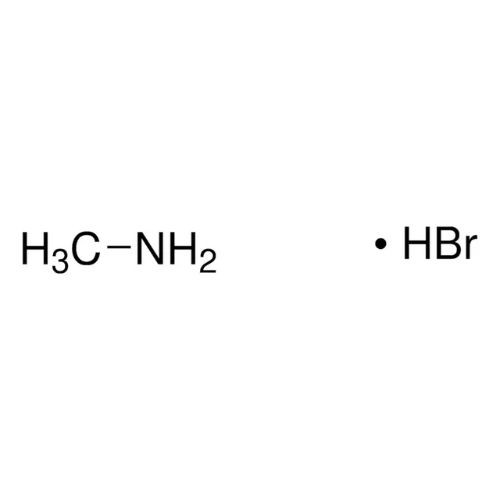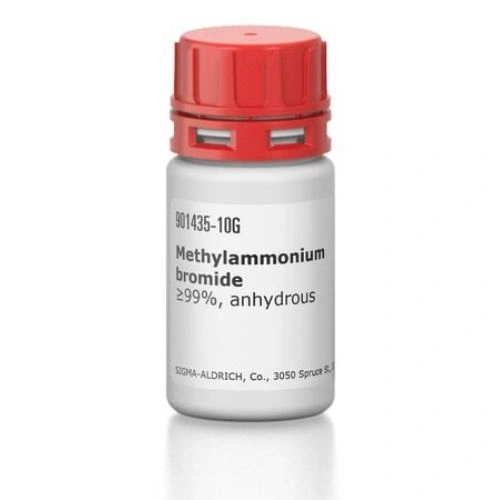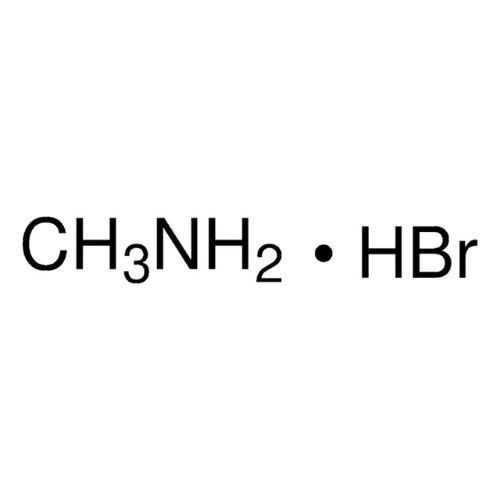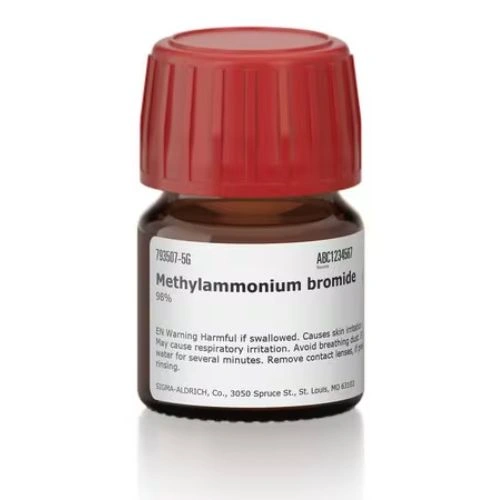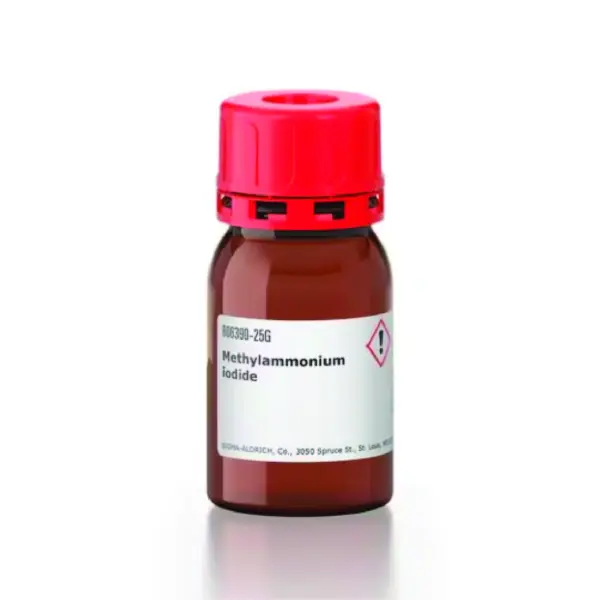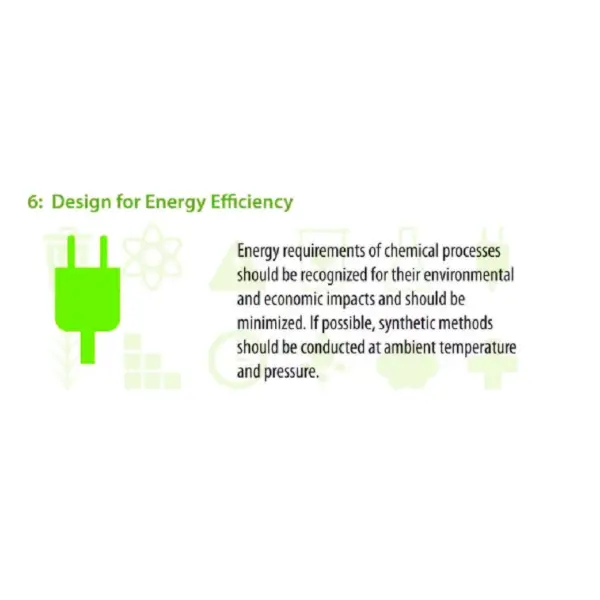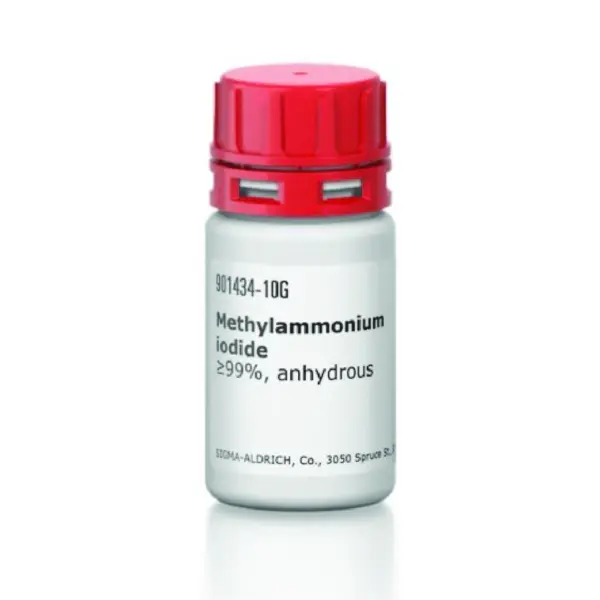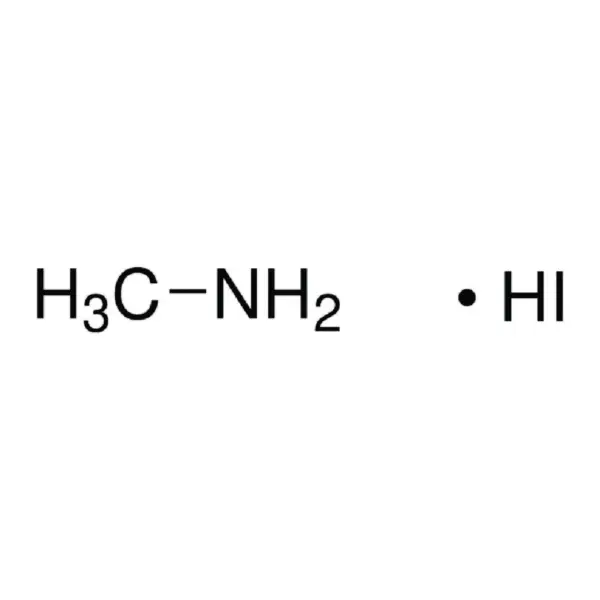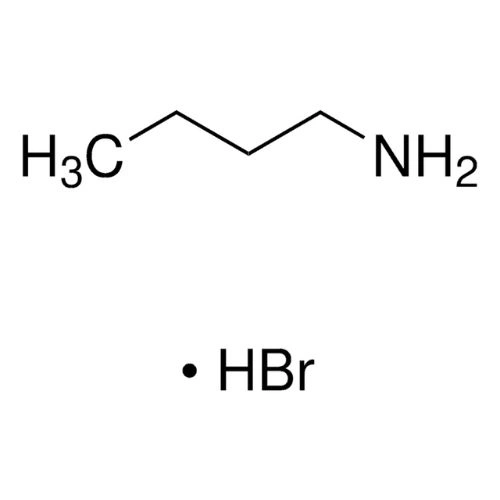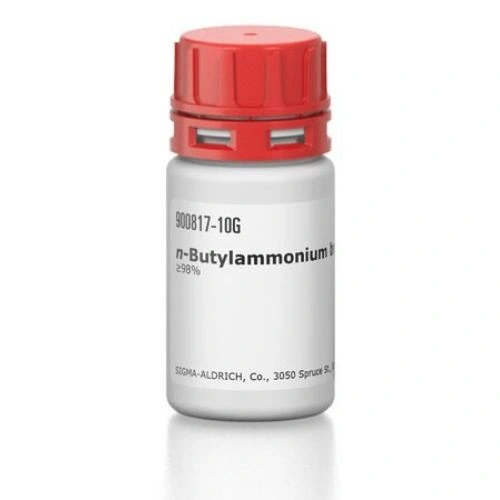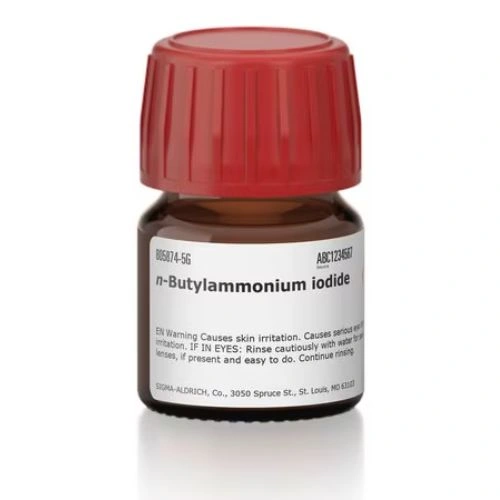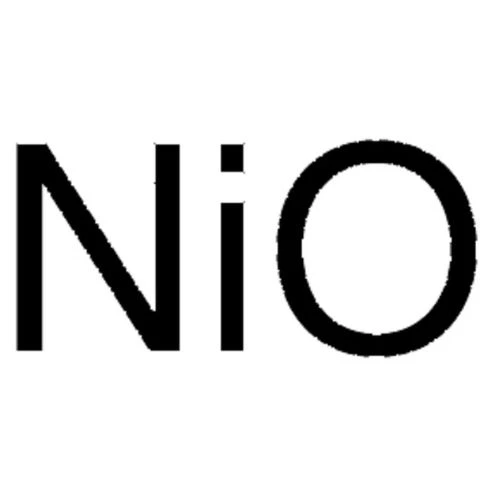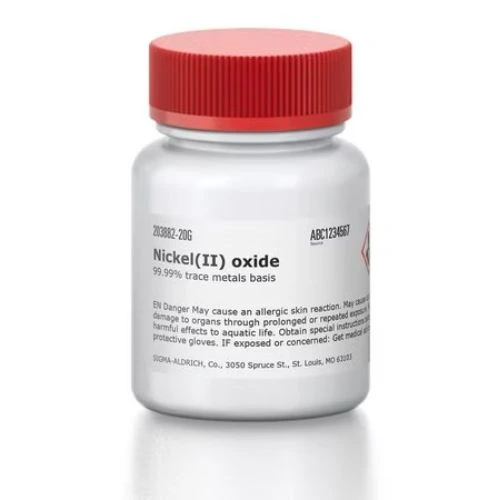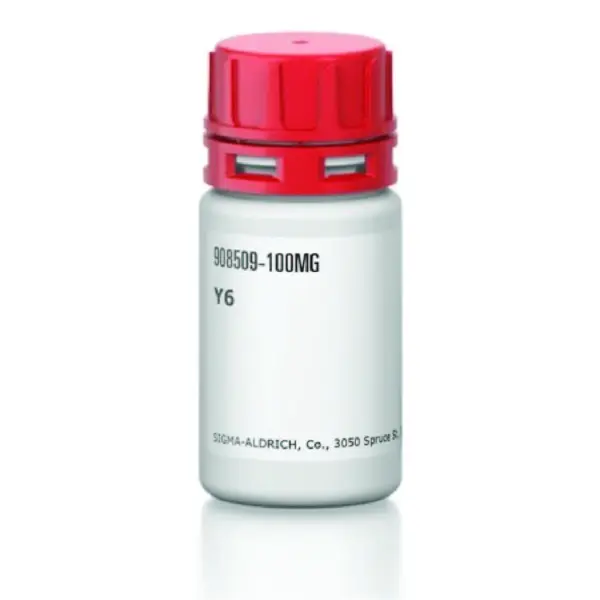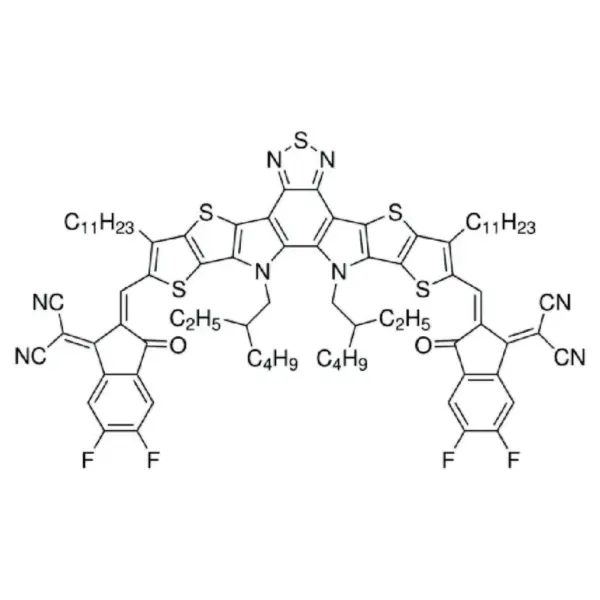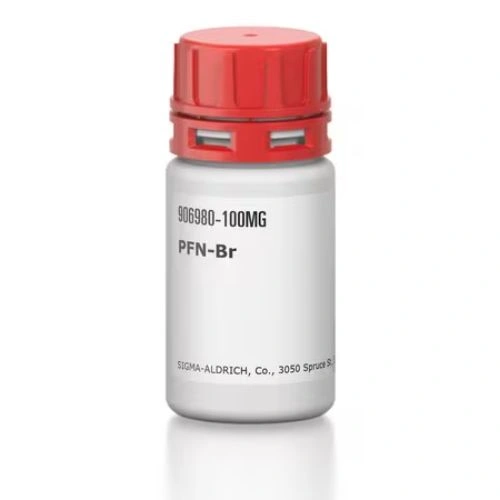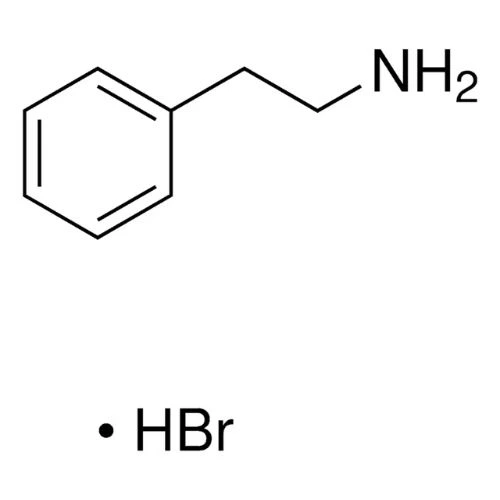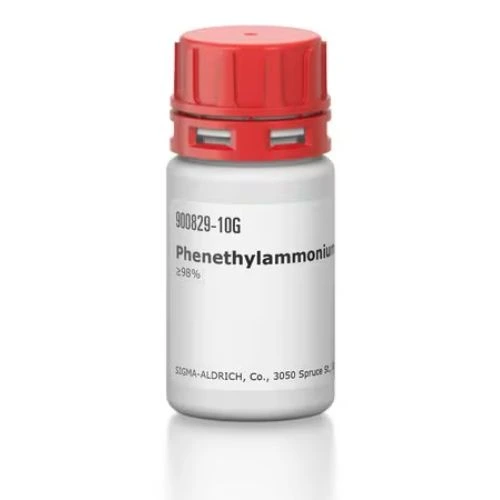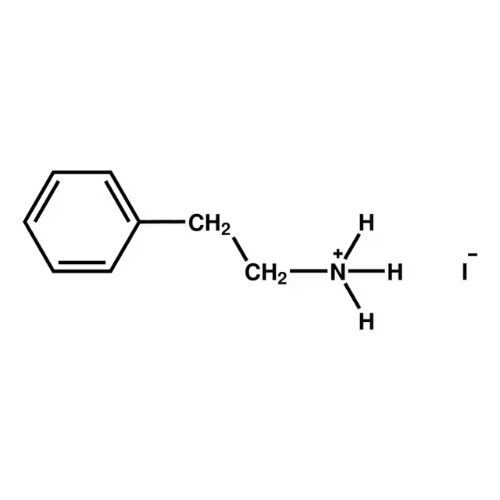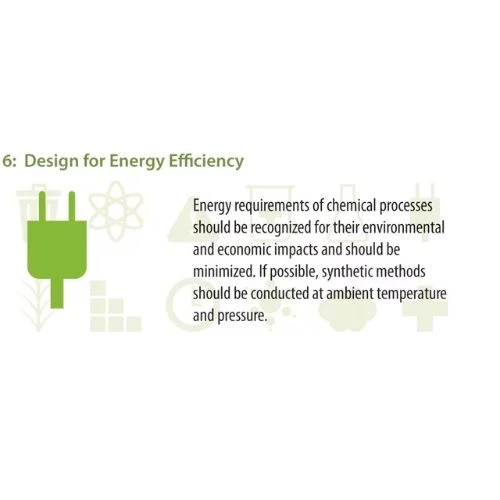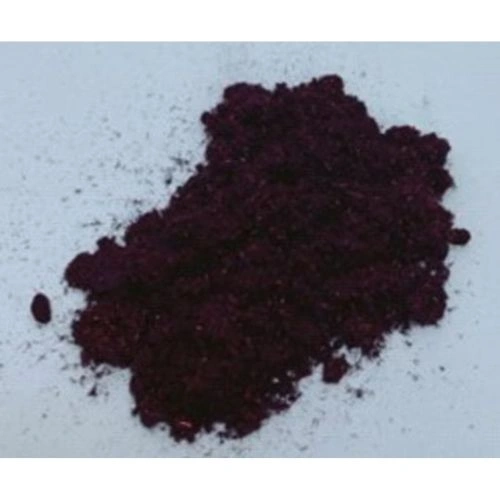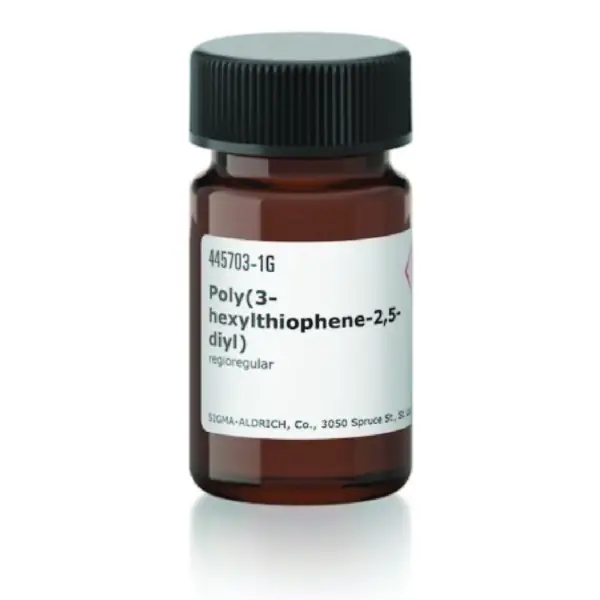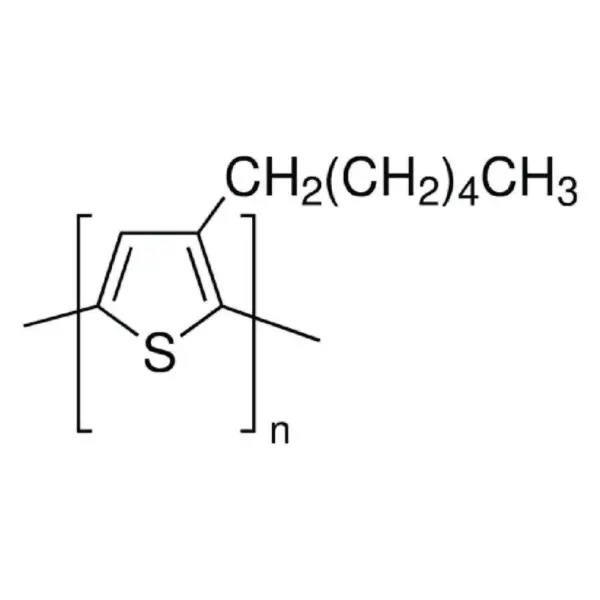Methylammonium bromide, ≥99%, anhydrous – Sigma-Aldrich
RM1,951.00Brand:
Sigma-Aldrich
Synonyms
Methanamine hydrobromide, methylamine hydrobromide
Cas No.
6876-37-5
General description
We are committed to bringing you Greener Alternative Products, which adhere to one or more of The 12 Principles of Greener Chemistry. This product has been enhanced for “Energy efficiency”.
Application
Methylammonium bromide (MABr) is used as an additive in the fabrication of perovskite solar cells. It helps improve the crystal quality and stability of the perovskite films, leading to enhanced photovoltaic performance.
Organohalide based perovskites have emerged as an important class of material for solar cell applications. Our perovskites precursors with extremely low water contents are useful for synthesizing mixed cation or anion perovskites needed for the optimization of the band gap, carrier diffusion length and power conversion efficiency of perovskites based solar cells.
Disclaimer
- Extremely hygroscopic.
- Handle in glove box.
- Handle and store under nitrogen atmosphere.
Methylammonium bromide, 98% – Sigma-Aldrich
RM1,292.00Brand:
Sigma-Aldrich
Synonyms
Methanamine hydrobromide, Methylamine, hydrobromide
Cas No.
6876-37-5
General description
We are committed to bringing you Greener Alternative Products, which adhere to one or more of The 12 Principles of Greener Chemistry. This product has been enhanced for energy efficiency. Find details here.
Application
Methylamine hydobromide is an important precursor for the preparation of perovskite photoactive layers for solar energy conversion.
Methylammonium bromide (MABr) can be used as a precursor in the preparation of methylammonium lead bromide based perovskite material with good optical properties, which include green emission, and photoluminescence. This material can further be utilized in the fabrication of renewable energy devices such as light emitting diodes(LEDs), perovskite solar cells (PSCs), and photovoltaic cells.
Methylammonium iodide | Greatcell Solar® – Sigma Aldrich
RM3,463.00Brand:
Sigma-Aldrich
Synonyms
Methanamine hydriodide, Greatcell Solar®, Methanaminium iodide, Methylamine hydriodide, Methylamine hydroiodide, Monomethylammonium iodide
General Description
We are committed to bringing you Greener Alternative Products, which adhere to one or more of The 12 Principles of Greener Chemistry. This product has been enhanced for energy efficiency. Click here for more details.
Application
Methylammonium iodide (MAI) can be used as a precursor in combination with lead iodide to change the morphology of the perovskite materials. Perovskite materials can further be utilized in the fabrication of alternative energy devices such as light emitting diodes (LEDs), and perovskite solar cells (PSCs).
Methylammonium iodide (MAI) is utilized in the production of various optoelectronic devices, including light-emitting diodes (LEDs), photodetectors and lasers. MAI is employed in the synthesis of perovskite-based semiconductors, which have garnered interest in the field of electronics due to their exceptional photovoltaic and optoelectronic properties. MAI can be used to sensitize other types of solar cells, such as dye-sensitized solar cells (DSSCs), by enhancing light absorption and electron transfer processes.
The iodide and bromide based alkylated halides find applications as precursors for fabrication of perovskites for photovoltaic applications.
Legal Information
Product of Greatcell Solar®
Greatcell Solar is a registered trademark of Greatcell Solar
| Linear Formula | CH3NH2 • HI |
| CAS Number | 14965-49-2 |
| Molecular Weight | 158.97 |
| MDL number | MFCD28100833 |
| UNSPSC Code | 12352302 |
| NACRES | Na.23 |
| Greener alternative product characteristics | Design for Energy Efficiency |
Methylammonium Iodide, ≥99%, anhydrous – Sigma-Aldrich
RM2,000.00Brand:
Sigma-Aldrich
Synonyms
Methanamine, hydriodide
General Description
We are committed to bringing you Greener Alternative Products, which adhere to one or more of the 12 Principles of Greener Chemistry. This product has been enhanced for energy efficiency. Click here for more details.
Application
Methylammonium iodide (MAI) has been widely used in the development of perovskite solar cells. MAI is typically used as a precursor material in the fabrication of perovskite thin films. It acts as a source of methylammonium cations (CH3NH3+) and iodide anions (I-) that are necessary for the formation of the perovskite crystal structure.
Methylammonium iodide, an organic halide-based perovskite material, can be used in the fabrication of high-performance organic solar cells.
Organohalide-based perovskites have emerged as an important class of material for solar cell applications. Our perovskite precursors with extremely low water contents are useful for synthesising mixed cation or anion perovskites needed for the optimization of the band gap, carrier diffusion length and power conversion efficiency of perovskite-based solar cells.
| Lineaer Formula | CH3NH2 • HI |
| CAS Number | 14965-49-2 |
| Molecular Weight | 158.97 |
| MDL number | MFCD28100833 |
| UNSPSC Code | 12352302 |
| NACRES | Na.23 |
| Greener alternative product characteristics | Design for Energy Efficiency |
Methylammonium iodide, 98% – Sigma Aldrich
RM1,309.00Brand:
Sigma-Aldrich
Synonyms
Methanamine hydriodide
Application
Methanamine hydriodide is an important precursor for the preparation of perovskite photoactive layers for solar energy conversion. Methylammonium iodide (MAI) is extensively used as a precursor material for the fabrication of perovskite solar cells. These solar cells offer high conversion efficiencies.
Methylammonium iodide can be used as a precursor in combination with lead iodide to change the morphology of the resulting perovskite materials. Perovskite materials can further be utilized in the fabrication of alternative energy devices such as light emitting diodes (LEDs), and perovskite solar cells (PSCs).
Other Notes
We are committed to bringing you Greener Alternative Products, which adhere to one or more of The 12 Principles of Greener Chemistry. This product has been enhanced for energy efficiency. Find details here.
| CAS Number | 14965-49-2 |
| Molecular Weight | 158.97 |
| MDL number | MFCD28100833 |
| UNSPSC Code | 12352302 |
| NACRES | Na.23 |
| Greener alternative product characteristics | Design for Energy Efficiency |
n-Butylammonium bromide, ≥98% – Sigma-Aldrich
Price range: RM554.00 through RM1,004.00Brand:
Sigma-Aldrich
Synonyms
1-Butanamine hydrobromide (1:1), 1-Butanaminium bromide, Butyl ammonium bromide, Greatcell Solar®
Cas No.
15567-09-6
General description
We are committed to bringing you Greener Alternative Products, which adhere to one or more of The 12 Principles of Greener Chemistry. This product has been enhanced for energy efficiency. Click here for more details.
Application
Organohalide based perovskites have emerged as an important class of material for solar cell applications. Our perovskites precursors are useful for synthesizing mixed cation or anion perovskites needed for the optimization of the band gap, carrier diffusion length and power conversion efficiency of perovskites based solar cells.
n-Butylammonium bromide can serve as a solvent or part of a solvent system in the fabrication of solar cells or electronic devices. It can be utilized as a precursor or additive in the synthesis of perovskite materials used in solar energy applications.
Legal Information
Product of Greatcell Solar Materials Pty Ltd.
Greatcell Solar is a registered trademark of Greatcell Solar Materials Pty Ltd.
Greatcell Solar is a registered trademark of Greatcell Solar
n-Butylammonium iodide – Sigma-Aldrich
Price range: RM1,963.00 through RM2,921.00Brand:
Sigma-Aldrich
Synonyms
1-Butanaminium iodide, Butylamine hydroiodide, Butylammonium iodide, Greatcell Solar®
Cas No.
36945-08-1
General description
We are committed to bringing you Greener Alternative Products, which adhere to one or more of The 12 Principles of Greener Chemistry. This product has been enhanced for energy efficiency. Click here for more details.
Application
n-Butylammonium iodide (BAI) can be used as an additive that facilitates an improvement in the efficiency and stability of perovskite solar cells (PSCs). It can also be used as an organic ligand in the formation of organic-inorganic perovskites for light-emitting diodes (LEDs).
The iodide and bromide based alkylated halides find applications as precursors for fabrication of perovskites for photovoltaic applications.
Legal Information
Product of Greatcell Solar Materials Pty Ltd.Greatcell Solar is a registered trademark of Greatcell Solar Materials Pty Ltd.
Greatcell Solar is a registered trademark of Greatcell Solar
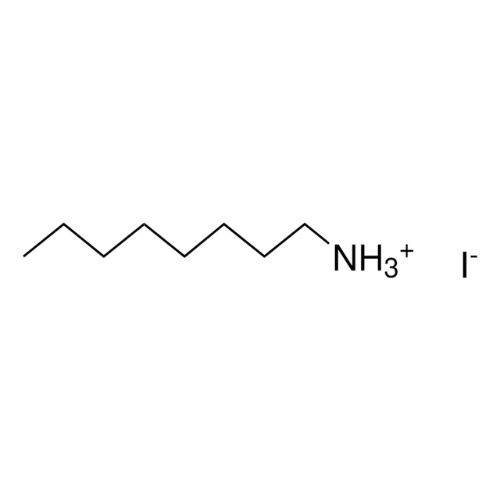
n-Octylammonium iodide, Greatcell Solar® – Sigma-Aldrich
Price range: RM553.00 through RM1,844.00Brand:
Sigma-Aldrich
Synonyms
1-Octanamine, hydriodide (9CI), n-Octylammonium iodide, Greatcell Solar®, NOAI, Octylammonium iodide
Cas No.
60734-63-6
Application
Incorporating n-Octylammonium iodide into the perovskite layer can lead to improved stability of the solar cell. It helps reduce the presence of defects and grain boundaries within the perovskite film, which can enhance the long-term stability and durability of the device under operating conditions. The choice of organic cation, such as n-Octylammonium iodide, in the perovskite layer can contribute to enhancing the power conversion efficiency of the solar cell.
Organohalide based perovskites have emerged as an important class of material for solar cell applications. The variations/substitution in organohalide cations and anions is employed for the optimization of the band gap, carrier diffusion length, and power conversion efficiency of perovskites based solar cells.
Legal Information
Product of Greatcell Solar Materials Pty Ltd.
Greatcell Solar is a registered trademark of Greatcell Solar Materials Pty Ltd.
Greatcell Solar is a registered trademark of Greatcell Solar
Nickel oxide Ni(II), 99.99% trace metals basis – Sigma-Aldrich
Price range: RM800.00 through RM3,064.00Brand:
Sigma-Aldrich
Synonyms
Nickel monoxide, Nickel(II) oxide, Nickelous oxide
Cas No.
1313-99-1
Application
Nickel(II) oxide can be used for a variety of sustainable applications such as:
non-enzymatic glucose sensor
hydrogen production
dye-sensitized solar cells (DSSCs)
Non fullerene acceptor Y6 – Sigma-Aldrich
RM1,928.00Brand:
Sigma-Aldrich
Synonyms
BTP-4F, Y6, PCE 157
CAS No
2304444-49-1
General Description
Non-fullerene acceptors (NFAs) are currently a major focus of research in the development of bulk-heterojunction organic solar cells (OSCs). In contrast to the widely used fullerene acceptors (FAs), the optical properties and electronic energy levels of NFAs can be designed and readily tuned. NFA-based OSCs can also achieve greater thermal stability and photochemical stability, as well as longer device lifetimes, than their FA-based counterparts.Recent developments have led to a rapid increase in power conversion efficiencies for NFA OSCs, with values now exceeding 15% in a single junction cell, and >17% for a tandem cell, demonstrating the viability of using NFAs to replace FAs in next-generation high-performance OSCs.
Y6 is a non-fullerene acceptor-donor-acceptor (A-D-A) type small molecular acceptor (SMA) with flexible alkyl chains and a centrally fused ring. It has a ladder-type electron-deficient core, which can be blended with PM6 for organic photovoltaic applications.
Applications
Y6 is a non-fullerene acceptor (NFA) that uses an electron-deficient molecular core to obtain a low band gap with improved electron affinity. OPV devices made from Y6 can reach exceptionally high performances in single-junction devices, with a maximum PCE reported of 15.7% (14.9% certified by Enli Tech Laboratory) when paired with PM6. Y6 is versatile and can be employed in both conventional and inverted OPV device architectures and can maintain a high PCE with varying active layer thicknesses (13.6% in thick 300 nm layers).
Y6 is used as an electron acceptor material in organic solar cells. It has shown promising results in improving the power conversion efficiency of organic solar cells. Y6 and its derivatives are also used in material engineering studies to understand the relationships between molecular structure, morphology and device performance in organic photovoltaics.
PEDOT:PSS, conductive grade, 1.3 wt. % aqueous dispersion – Sigma-Aldrich
RM1,317.00Brand:
Sigma-Aldrich
Synonyms
PEDOT:PSS, Poly(2,3-dihydrothieno-1,4-dioxin)-poly(styrenesulfonate)
CAS No
–
General Description
A conducting polymer such as poly(3,4-ethylenedioxythiophene) doped with poly(styrene sulfonate) anions (PEDOT/PSS) is widely used in various organic optoelectronic devices. High electrical conductivity and good oxidation resistance of such polymers make it suitable for electromagnetic shielding and noise suppression. Thus, the polymer film was found to possess high transparency throughout the visible light spectrum and even into near IR and near UV regions, virtually 100% absorption from 900-2,000 nm. No absorption maximum from 400-800 nm. Conductive polymer blend. Impact of small electric and magnetic fields on the polymer was studied.
We are committed to bringing you Greener Alternative Products, which adhere to one or more of the 12 Principles of Green Chemistry. This product is used in energy conversion and storage, thus has been enhanced for energy efficiency. Click here for more information.
Applications
PEDOT:PSS polymeric films have been used as a charge dissipation layer in electron-beam lithography and focused ion beam milling. Sample preparation has been reported to be easier and quicker for various substrates, including gallium nitride (GaN) on sapphire (Al2O3) substrates, zinc oxide (ZnO), fused silica, lithium niobate (LiNbO3), silicon carbide (SiC) and diamond (C), spin-coated onto the ITO coated glass substrate. PEDOT: PSS layers have also been reported to be used as anode buffer layer for organic solar cells and as replacements for the transparent conductive coatings of organic solar cells. Various studies report the use of metal modified conductive grade PEDOT: PSS as an anode buffer layer in solar cells, example: copper phthalocyanine/fullerene-based solar cells 4 Conductive PEDOT:PSS combined with polyvinylidene fluoride (PVDF) membranes may be used to prepare PEDOT:PSS-PVDF ionic liquid soft actuators. The function of PEDOT:PSS as a pseudocapacitive material was investigated.
Virtually 100% absorption from 900-2,000 nm. No absorption maximum from 400-800 nm. Conductive polymer blend.
Features & Benefits
Antistat coating for plastic and glass.
Packaging
Packaged in glass bottles
PEDOT:PSS, conductive inkjet ink, 0.8% aqueous dispersion – Sigma-Aldrich
RM928.00Brand:
Sigma-Aldrich
Synonyms
Orgacon™ IJ-1005, PEDOT:PSS, Poly(2,3-dihydrothieno-1,4-dioxin)-poly(styrenesulfonate)
CAS No
–
General Description
Poly(3,4-ethylenedioxythiophene)-poly(styrenesulfonate) (PEDOT:PSS) is an organic semiconductor wherein conjugated PEDOT is doped with sulfonated PSS, which acts as a counter ion. PEDOT is responsible for the conduction mechanism and the hydrated colloidal solution formed by PSS.
PEDOT:PSS has high electrical conductivity and good oxidation resistance, the properties which make it suitable for electromagnetic shielding and noise suppression. Thus, the polymeric film formed possesses high transparency throughout the visible light spectrum and even in near IR and near UV regions, displaying virtually 100% absorption from 900-2,000 nm. No absorption maximum from 400-800 nm was observed.
We are committed to bringing you Greener Alternative Products, which adhere to one or more of the 12 Principles of Green Chemistry. This product is used in energy conversion and storage, thus has been enhanced for energy efficiency. Click here for more information.
Applications
PEDOT:PSS acts as an intrinsically conductive polymer, which can be coated on a variety of substrates and nanoparticles like fullerenes (C60) for the low-cost printing of electronics and optoelectronics based applications. Conductive hydrogels can be prepared by using PEDOT:PSS with polyethylene glycol-diacrylate, which can be potentially used in tissue engineering.
Virtually 100% absorption from 900-2,000 nm. No absorption maximum from 400-800 nm. Conductive polymer blend.
Legal Information
Product of Agfa-Gevaert N.V.
Orgacon is a trademark of Agfa-Gevaert N.V.
PEDOT:PSS, high-conductivity grade, 1.1% aqueous dispersion, surfactant-free – Sigma-Aldrich
RM1,293.00Brand:
Sigma-Aldrich
Synonyms
Orgacon™ ICP 1050, PEDOT:PSS, Poly(2,3-dihydrothieno-1,4-dioxin)-poly(styrenesulfonate)
CAS No
–
General Description
Aqueous surfactant-free dispersion of high conductivity grade PEDOT:PSS polymer. Optimal performance in transparent conductive coatings may require addition of formulation ingredients (e.g. surfactants and high-boiling solvents).Conducting polymer such as poly(3,4-ethylenedioxythiophene) doped with poly(styrene sulfonate) anions (PEDOT/PSS) is widely used in various organic optoelectronic devices. PEDOT: PSS is a blend of cationic polythiopene derivative, doped with a polyanion. High electrical conductivity and good oxidation resistance of such polymers make it suitable for electromagnetic shielding and noise suppression. Thus, the polymer film was found to possess high transparency throughout the visible light spectrum and even into near IR and near UV regions, virtually 100% absorption from 900-2,000 nm. No absorption maximum from 400-800 nm. Impact of small electric and magnetic fields on the polymer was studied.
Poly(3,4-ethylenedioxythiophene)-poly(styrenesulfonate) (PEDOT:PSS) is a conductive polymer without a high boiling solvent (HBS), that is formed by electropolymerizing 3,4-ethylenedioxythiophene in a solution of poly(styrenesulfonate) (PSS). PEDOT is doped with positive ions and PSS with negative ions. It has the following properties that make it a viable polymer in organic electronics.
We are committed to bringing you Greener Alternative Products, which adhere to one or more of the 12 Principles of Green Chemistry. This product is used in energy conversion and storage, thus has been enhanced for energy efficiency. Click here for more information.
Applications
PEDOT:PSS can be used as an electrode material with high mobility for charge carriers. It can be used for a wide range of energy based applications such as organic photovoltaics (OPV), perovskite solar cells (DSSCs), organic light emitting diodes (OLEDs) and other biomedical sensors.
Used to prepare highly transparent conductive coating formulations. Primary and secondary nucleation by introducing PEDOT:PSS in a hydrogel was studied.
Virtually 100% absorption from 900-2,000 nm. No absorption maximum from 400-800 nm. Conductive polymer blend.
Legal Information
Product of Agfa-Gevaert N.V.
Orgacon is a trademark of Agfa-Gevaert N.V.
PEDOT:PSS, high-conductivity grade, 1.5% aqueous dispersion, neutral pH – Sigma-Aldrich
RM2,115.00Brand:
Sigma-Aldrich
Synonyms
Orgacon™ N-1005, PEDOT:PSS, Poly(2,3-dihydrothieno-1,4-dioxin)-poly(styrenesulfonate)
CAS No
–
General Description
Aqueous surfactant-free dispersion of PEDOT:PSS neutralized to pH >5. Suitable for preparation of pH-neutral transparent conductive films printed electronics applications (e.g. hole injection layers). A conducting polymer such as poly(3,4-ethylenedioxythiophene) doped with poly(styrene sulfonate) anions (PEDOT/PSS) is widely used in various organic optoelectronic devices. PEDOT: PSS is a blend of cationic polythiopene derivative, doped with a polyanion. High electrical conductivity and good oxidation resistance of such polymers make it suitable for electromagnetic shielding and noise suppression. Thus, the polymer film was found to possess high transparency throughout the visible light spectrum and even into near IR and near UV regions, virtually 100% absorption from 900-2,000 nm. No absorption maximum from 400-800 nm. Impact of small electric and magnetic fields on the polymer was studied.
Poly(3,4-ethylenedioxythiophene)-poly(styrenesulfonate) (PEDOT:PSS) is a conductive polymer that is formed by electropolymerizing 3,4-ethylenedioxythiophene in a solution of poly(styrenesulfonate) (PSS). PEDOT is doped with positive ions and PSS with negative ions. PEDOT:PSS is majorly used in organic electronics due to the properties such as:
- low band gap
- good optical properties
- high conductivity
- low redox potential
- easy processing
- tunable film forming ability
We are committed to bringing you Greener Alternative Products, which adhere to one or more of the 12 Principles of Green Chemistry. This product is used in energy conversion and storage, thus has been enhanced for energy efficiency. Click here for more information.
Applications
PEDOT:PSS can be used as an electrode material that forms a layered structure with a high mobility for charge carriers. It can be used for a wide range of energy based applications, such as organic photovoltaics (OPVs), dye sensitized solar cells (DSSCs), organic light emitting diodes (OLEDs) and supercapacitors.
Virtually 100% absorption from 900-2,000 nm. No absorption maximum from 400-800 nm. Conductive polymer blend.
Features & Benefits
Reduced mean particle size with a tighter distribution of sizes allows for the creation of a smooth surface on the ITO electrode, and so electric “shorts” in LED devices can be reduced. Greatly reduced inherent conductivity reduces the occurrence of “cross-talk” in very small pixel (less than 10 micron) matrix array displays.
Legal Information
Product of Agfa
Orgacon is a trademark of Agfa-Gevaert N.V.
PEDOT:PSS, high-conductivity grade, 3.0-4.0% aqueous dispersion – Sigma-Aldrich
Price range: RM297.00 through RM1,187.00Brand:
Sigma-Aldrich
Synonyms
PEDOT:PSS, Poly(2,3-dihydrothieno-1,4-dioxin)-poly(styrenesulfonate)
CAS No
–
General Description
Poly(3,4-ethylenedioxythiophene)-poly(styrenesulfonate) (PEDOT:PSS) is an organic semiconductor prepared by doping cationic poly(3,4-ethylenedioxythiophene) and poly(4-styrenesulfonate) anion. Its high electrical conductivity and good oxidation resistance make it suitable for electromagnetic shielding and noise suppression. PEDOT:PSS based polymeric films have a high transparency throughout the visible light spectrum and even in near IR and near UV regions, with virtually 100% absorption from 900-2000 nm. PEDOT provides the conduction properties and PSS forms a hydrated colloidal solution.
We are committed to bringing you Greener Alternative Products, which adhere to one or more of the 12 Principles of Green Chemistry. This product is used in energy conversion and storage, thus has been enhanced for energy efficiency. Click here for more information.
Applications
Electrical conductivity measurements herewith reported were on a film deposited by spin-coating on a clean glass, then dried (130 °C for 15 minutes on a hotplate). The layer thickness was determined by scratching the layer and measuring the profile/height of the scratch by a stylus profilometer. Electrodes for the measurement were by evaporating metal contacts (four-point probes).
PEDOT:PSS is an intrinsically conductive polymer (ICP) that can be coated on various substrates and nanostructures like fullerenes (C60) to form composites with high electrochemical properties for applications like low-cost printed electronics, optoelectronics, and polymeric solar cells. It can be used as a conductive hydrogel with polyethylene glycol-diacrylate (PEG-DA) for potential applications in tissue engineering. PEDOT:PSS also finds use in other organic electronic applications like organic thin film transistors (OTFTs) and dye sensitized solar cells (DSSCs).
Ready-to-use high conductivity coating formulation.
Virtually 100% absorption from 900-2,000 nm. No absorption maximum from 400-800 nm. Conductive polymer blend.
Packaging
Packaged in poly bottles
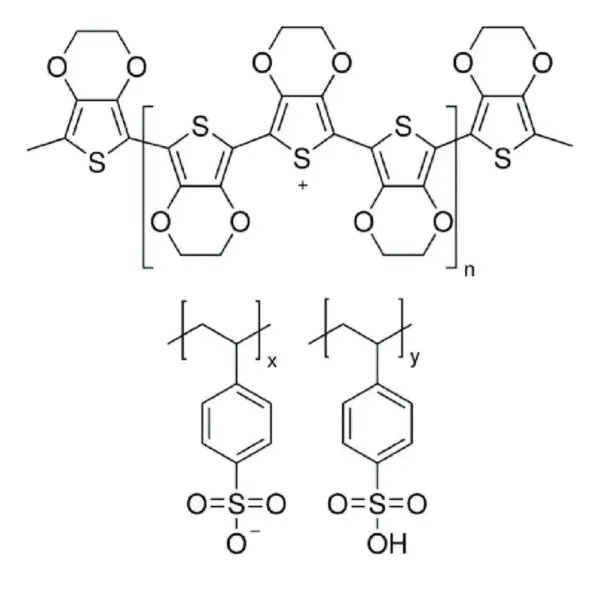
PEDOT:PSS, low-conductivity grade, 2.7 wt. % aqueous dispersion – Sigma-Aldrich
Price range: RM668.00 through RM1,622.00Brand:
Sigma-Aldrich
Synonyms
PEDOT:PSS, Poly(2,3-dihydrothieno-1,4-dioxin)-poly(styrenesulfonate)
CAS No
–
General Description
A conducting polymer such as poly(3,4-ethylenedioxythiophene) doped with poly(styrene sulfonate) anions (PEDOT/PSS) is widely used in various organic optoelectronic devices. PEDOT: PSS is a blend of cationic polythiopene derivative, doped with a polyanion. High electrical conductivity and good oxidation resistance of such polymers make it suitable for electromagnetic shielding and noise suppression. Thus, the polymer film was found to possess high transparency throughout the visible light spectrum and even into near IR and near UV regions, virtually 100% absorption from 900-2,000 nm. No absorption maximum from 400-800 nm. Conductive polymer blend. Impact of small electric and magnetic fields on the polymer was studied.
Poly(3,4-ethylenedioxythiophene)-poly(styrenesulfonate) (PEDOT:PSS) is an intrinsically conducting polymer (ICP) that is prepared by blending poly(3,4-ethylenedioxythiophene) (PEDOT) and sodium poly(styrenesulfonate) (PSS). It is an aqueous emulsion in which PEDOT is positively charged and the PSS is the counter ion (negatively charged). It can act as an anode or a cathode material based on the application. It can be spin-coated on different substrates at 1000-5000 rpm.
Preferably applied by spin-coating. Filtration of the dispersion through a 0.45 μm memberane filter is recommended before use. The coatings are dried at a maximum temperature of 200 °C for 1 minute, but a temperature between 50 °C and 150 °C is usually sufficient. The optimal thickness of the dried layer is in the range of 50-250 nm.
Applications
PEDOT:PSS and poly(9-vinylcarbazole) (PVK) can be cross-linked to form a multi-layered organic light emitting diodes. Proton exchange membranes such as Nafion 212 can be coated layer by layer with PEDOT:PSS and poly(allylamine hydrochloride) (PAH).[9]
Useful as an interfacial hole injection layer in OLED and PLED devices to lower operating voltages, increase luminescence efficiency, and enhance display lifetimes.
Virtually 100% absorption from 900-2,000 nm. No absorption maximum from 400-800 nm. Conductive polymer blend.
Features & Benefits
Reduced mean particle size with a tighter distribution of sizes allows for the creation of a smooth surface on the ITO electrode, and so electric “shorts” in LED devices can be reduced. Greatly reduced inherent conductivity reduces the occurrence of “cross-talk” in very small pixel (less than 10 micron) matrix array displays.
Packaging
Packaged in poly bottles
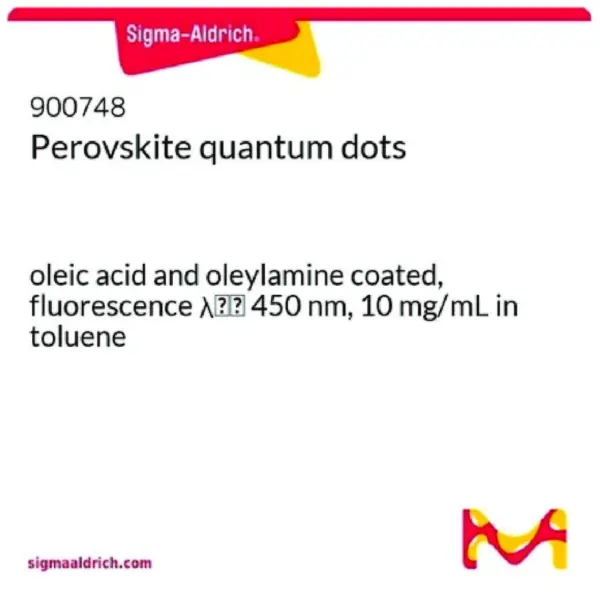
Perovskite quantum dots oleic acid and oleylamine coated, fluorescence λem 450 nm, 10 mg/mL in toluene – Sigma-Aldrich
RM992.00Brand:
Sigma-Aldrich
Synonyms
Cadmium free QDs, Fluorescent nanocrystals, Perovskite nanocrystals, QDs
Applications
For Perovskite quantum dots:
Perovskite quantum dots (QDs) of common formula CsPbX3 (X = Cl, Br, I) possess high photoluminescence efficiency and narrow emission and emit in the visible spectral regime. Perovskite QDs are cadmium free and the aforementioned properties render them suitable for applications in light emitting diodes (LEDs), lasers, liquid crystal displays (LCDs) etc.
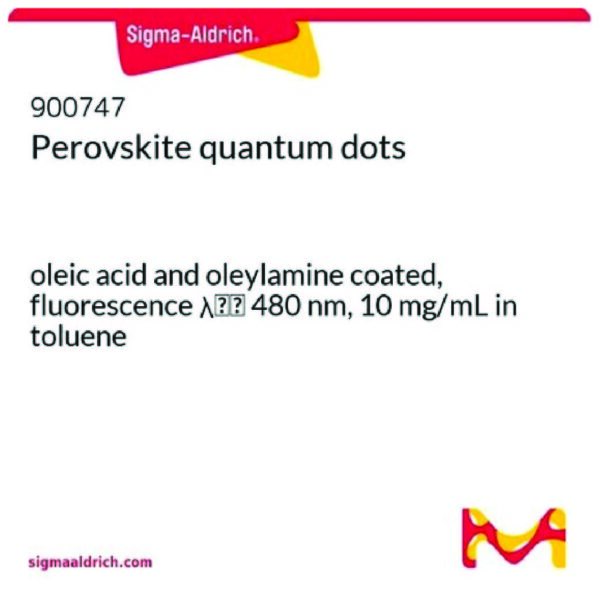
Perovskite quantum dots oleic acid and oleylamine coated, fluorescence λem 480 nm, 10 mg/mL in toluene – Sigma-Aldrich
RM997.00Brand:
Sigma-Aldrich
Synonyms
Cadmium free QDs, Fluorescent nanocrystals, Perovskite nanocrystals, QDs
Applications
For Perovskite quantum dots:
Perovskite quantum dots (QDs) of common formula CsPbX3 (X = Cl, Br, I) possess high photoluminescence efficiency and narrow emission and emit in the visible spectral regime. Perovskite QDs are cadmium free and the aforementioned properties render them suitable for applications in light emitting diodes (LEDs), lasers, liquid crystal displays (LCDs) etc.
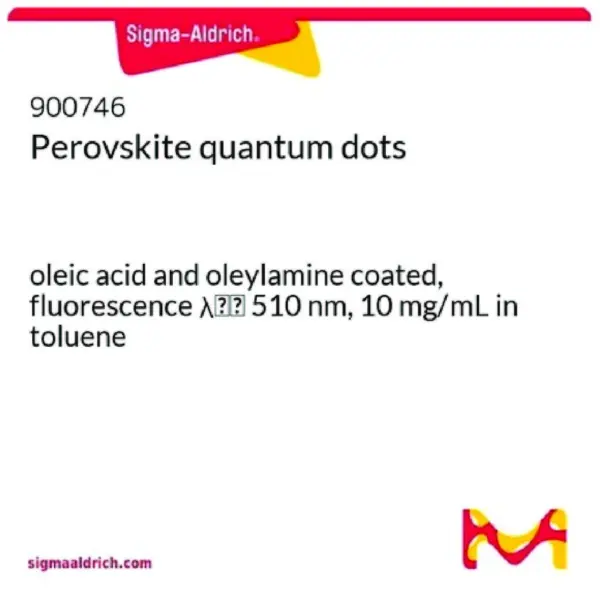
Perovskite quantum dots oleic acid and oleylamine coated, fluorescence λem 510 nm, 10 mg/mL in toluene – Sigma-Aldrich
RM2,016.00Brand:
Sigma-Aldrich
Synonyms
Cadmium free QDs, Fluorescent nanocrystals, Perovskite nanocrystals, QDs
Applications
For Perovskite quantum dots:
Perovskite quantum dots (QDs) of common formula CsPbX3 (X = Cl, Br, I) possess high photoluminescence efficiency and narrow emission and emit in the visible spectral regime. Perovskite QDs are cadmium free and the aforementioned properties render them suitable for applications in light emitting diodes (LEDs), lasers, liquid crystal displays (LCDs) etc.
PFN-Br – Sigma-Aldrich
RM1,862.00Brand:
Sigma-Aldrich
Synonyms
OS0995, PFN-P2, Poly(9,9-bis(3’-(N,N-dimethyl)-N-ethylammoinium-propyl-2,7-fluorene)-alt-2,7-(9,9-dioctylfluorene))dibromide
Cas No.
889672-99-5
General description
We are committed to bringing you Greener Alternative Products, which adhere to one or more of The 12 Principles of Greener Chemistry. This product belongs to Enabling category of greener alternatives thus aligns with “Design for energy efficency”. Electron transport organic materials have the chemical functionality to transport electrons and are used as electron transport layer in OLED devices. Click here for more information.
Application
PFN-Br is a solution processible, conjugated polymer electrolyte used as interficial layer in high performance organic photovoltaic cells (OPV) and organic light emitting diodes (OLED) to improve the interfacial properties.
OPV devices with PFN-Br interfacial layer showed overall enhanced short-circuit current density, open-circuit voltage, fill factor and corresponding high efficiency in the inverted OPVs. This was attributed to the good contact between ZnO electron extraction layer and the active layer, good interface adhesion between the electron extraction layer and active layer, and enhanced charge transport via suppressed bimolecular recombination.
Recent report of OPV with a record energy conversion efficiency of 17.3% also utilized PFN-Br, spin-coated on top of ZnO to improve the interfacial properties.
Tandem Cell Device performance:
ITO/ZnO/PFN-Br/PBDB-T:F-M/M-PEDOT/ZnO/PTB7- Th:O6T-4F:PC71BM/MoO3/Ag
Voc=1.642 V
Jsc=14.35 mA/cm2
FF=73.7%
PCE=17.3%
PFN-Br finds application in a wide range of areas:
- OPV interficial layer (metalic oxide compact layer)
- OLED electron transport layer
- Perovskite solar cells
- Flexible printed electronics
- Cationic polymer electrolyte
- Anion exchange material
- Light emitting electrochemical cells
Other Notes
Recommend to use 0.2 mg/ml concentration for electron-transport interfacial layer in OPV.
Phenethylammonium bromide, ≥98% – Sigma-Aldrich
Price range: RM437.00 through RM848.00Brand:
Sigma-Aldrich
Synonyms
Greatcell Solar®, Phenethylamine hydrobromide
Cas No.
53916-94-2
General description
We are committed to bringing you Greener Alternative Products, which adhere to one or more of The 12 Principles of Greener Chemistry. This product has been enhanced for energy efficiency. Click here for more details.
Application
Organohalide based perovskites have emerged as an important class of material for solar cell applications. Our perovskites precursors are useful for synthesizing mixed cation or anion perovskites needed for the optimization of the band gap, carrier diffusion length and power conversion efficiency of perovskites based solar cells.
Legal Information
Product of Greatcell Solar Materials Pty Ltd.
Greatcell Solar is a registered trademark of Greatcell Solar Materials Pty Ltd.
Greatcell Solar is a registered trademark of Greatcell Solar
Phenethylammonium iodide – Sigma-Aldrich
RM1,280.00Brand:
Sigma-Aldrich
Synonyms
Greatcell Solar®, Phenethylamine hydriodide
Cas No.
–
General description
We are committed to bringing you Greener Alternative Products, which adhere to one or more of The 12 Principles of Greener Chemistry. This product has been enhanced for energy efficiency. Click here for more details.
Application
The iodide and bromide based alkylated halides find applications as precursors for fabrication of perovskites for photovoltaic applications.
Legal Information
Product of Greatcell Solar Materials Pty Ltd.
Greatcell Solar® is a registered trademark of Greatcell Solar Materials Pty Ltd
Greatcell Solar is a registered trademark of Greatcell Solar
Phthalocyanine – Sigma-Aldrich
RM997.00Brand:
Sigma-Aldrich
Synonyms
Dehydrophthalocyanine, H2Pc, Pigment Blue 16
Cas No.
574-93-6
Application
Phthalocyanine is a versatile functional dye with a range of intriguing properties enabling them to find practical applications in various disciplines from organic electronics, energy harvesting and biomedicine. Its derivatives exhibit semiconducting properties, making them valuable materials in organic electronics. They can be incorporated as active layers in organic photovoltaic cells, organic field-effect transistors (OFETs), organic light-emitting diodes (OLEDs), and other organic electronic devices.
Phthalocyanine, also known as H2Pc, is a versatile functional dye with a range of intriguing properties enabling them to find practical applications in various disciplines from organic electronics, energy harvesting and biomedicine.
In the field of organic electronics, H2Pc has been explored as a popular Hole Injection Layer (HIL) material for organic light-emitting diode devices (OLEDs).This special compound has also been explored for solar cells application given its robust and intensely colored macrocycles (blue pigments) with high chem., thermal and light stability, properties that are of paramount importance for realistic photovoltaic applications. H2Pc have attracted special attention as photosensitizers for dye-sensitized solar cells (DSSCs).
In biomedicine, phthalocyanine can serve as selective fluorescent probes for bioanal. and bioimaging, and as efficient photosensitizers for photodynamic therapy of cancer and other non-cancerous conditions.
Poly(3-hexylthiophene-2,5-diyl) – Sigma-Aldrich
RM3,561.00Brand:
Sigma-Aldrich
Synonyms
P3HT
General Description
Poly(3-hexylthiophene) (P3HT) is a regioregular semiconducting polymer. It is used in organic electronics primarily because of its regular end-to-end arrangement of side chain, which allows efficient p- p stacking of the conjugated backbones. On account of the alkyl side group, P3HT is rendered hydrophobic in neutral state. Solution-to-solid phase transformation and thin film formation of poly(3-hexylthiophene) (P3HT) was reported in a study.
Poly(3-hexylthiophene-2,5-diyl) (P3HT) is a poly(alkylthiophene) based semiconducting polymer that is hydrophobic at neutral state and has π-π conjugation in its backbone. It has a hole mobility is in the range of 10-3-10-1 cm2V-1s-1 and is commonly used in the development of field-effect transistors (FETs) for a wide range of applications.
We are committed to bringing you Greener Alternative Products, which adhere to one or more of The 12 Principles of Greener Chemistry. This product belongs to Enabling category of greener alternatives thus aligns with “Design for energy efficency”. Hole transport organic materials allow perfect energy level alignment with the absorber layer and therefore efficient charge collection, are prone to degradation in ambient conditions.
Applications
For the characterization and solid-state properties of this polymer, see J. Am. Chem. Soc. .
P3HT, an electron donor that acts as a semiconducting active layer in combination with an electron acceptor like fullerene derivative (6,6)-phenyl C61-butyric acid methylester (PCBM), can be used to fabricate bulk heterojunction (HJT) based organic solar cells (OSCs).[4][5][6][7] Volatile organic compounds (VOCs) and electric sensor devices can be developed by using Langmuir-Schaefer (LS) films of P3HT and poly(3-octylthiophene)(P3OT). It can also be used with polystyrene to process a nano-scaled polymeric coating through spray coating onto carbon nanotube (CNT) powders.
Poly(3-hexylthiophene-2,5-diyl) may be used to fabricate ZnO nanowire arrays based photodiode. Regio- regular poly(3-hexylthiophene-2,5-diyl) may find extensive use as a semiconducting layer in organic thin film field effect transistor (FETs).
Rechargeable battery electrodes, electrochromic devices, chemical and optical sensors, light-emitting diodes, microelectrical amplifiers, field-effect transistors and non-linear optical materials.
Features & Benefits
Greater than 90% head-to-tail regiospecific conformation.
Good processibility, environmental stability and electroactivity.

